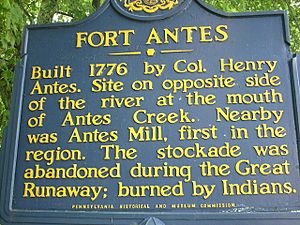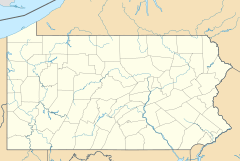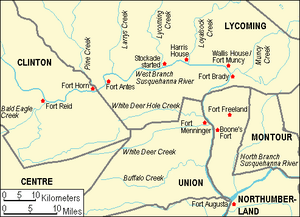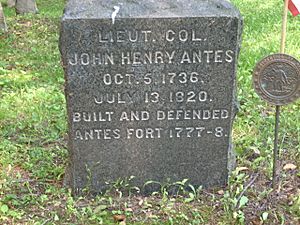Fort Antes facts for kids
|
Pennsylvania Historical Marker
|
|
| Location | Nippenose Township, Pennsylvania, USA |
|---|---|
| Nearest city | Jersey Shore, Pennsylvania |
| Coordinates | 41°11′28″N 77°14′19″W / 41.19111°N 77.23861°W |
| Area | 0.75 acres (3,000 m2) |
| Built/founded | 1777 or 1778 |
| PHMC dedicated | June 8, 1917 May 1, 1947 |
Fort Antes was a strong wooden fence, called a stockade, built around the home of Colonel John Henry Antes. It was put up around 1778 in Pennsylvania during the American Revolution. Colonel Antes, a member of the Pennsylvania militia (a group of citizen soldiers), oversaw its construction.
The fort was located on a flat area overlooking the West Branch Susquehanna River in Nippenose Township. This spot is south of what is now Jersey Shore, Pennsylvania. For a short time, local militia used the fort for protection. However, they were ordered to leave Fort Antes during an event known as the Big Runaway. Even though it was abandoned and attackers tried to burn it, Fort Antes was one of only two buildings in the valley to survive this event.
Contents
Who Was John Henry Antes?
John Henry Antes moved to the West Branch Susquehanna River area around 1772. His land was right on the edge of the Pennsylvania frontier, which was the border between settled areas and the wilderness. His neighbors to the west were outside the control of the Pennsylvania government. They formed a group called the Fair Play Men, who made their own rules.
Antes was a Justice of the Peace for Northumberland County. This meant he helped keep order and settled disagreements. He worked closely with the Fair Play Men, even performing their weddings. His stockade also offered some safety from attacks by local Native Americans. These groups were fighting back against European settlers moving onto their lands.
In 1773, Antes built a gristmill along Antes Creek. A gristmill grinds grain into flour. This was a very advanced building for the frontier. John Henry Antes served as a Justice of the Peace from 1775 to 1776. Then, he became a captain of 58 militiamen. After a military action near Wilkes-Barre, Antes returned home in mid-1777. That same year, he was promoted to Lieutenant Colonel.
A Frontier Outpost for Protection
Soon after the American Revolution began, Lenape warriors who were allies of the British started attacking the Pennsylvania frontier. Attacks in late 1777 near Pine Creek and Lock Haven made the Pennsylvania militia act. Colonel Samuel Hunter told Colonel Antes to gather local men at Antes' property.
These militia members built a strong stockade around the Antes home. The wooden fence was at least 12 feet (4 meters) high. It surrounded about three-quarters of an acre (3,000 square meters). Colonel Antes had to defend a large frontier area. It was constantly under attack from Native American and Tory forces. Tories were American colonists who stayed loyal to the British King. These forces were sent from Fort Niagara in New York.
Attacks Near Fort Antes
In June 1777, two settlers staying near Fort Antes were killed. A group of four men and two women had left the fort's safety. They crossed the West Branch of the Susquehanna River to milk some cows. Three men, Zephaniah Miller, Abel Cady, and James Armstrong, went into the woods to find a cow. They were attacked by warriors hiding there.
The sounds of fighting alerted the men at the fort. They crossed the river, even though Colonel Antes worried it might be a trap. On the other side, they found Miller dead. Cady and Armstrong were badly wounded and died later. Only one man, Bouser, and the two women, including Cady's wife, survived. This was just one of many attacks that made life very dangerous for settlers.
The Wyoming Valley Massacre and Evacuation Order
The constant attacks and lack of help from the Pennsylvania government worried the settlers. News of upcoming attacks came from a friendly Native American named Job Chilloway. He had been converted to Christianity by Moravian missionaries.
A major battle and massacre happened on July 3, 1778, in the Wyoming Valley near Wilkes-Barre. Attackers first overwhelmed small settler forts. Then, they killed many women and children who had sought safety there. This terrible news led local authorities to order everyone to leave the entire West Branch valley.
Even though Colonel Antes and his men built Fort Antes, they had to abandon it in July 1778 during the Big Runaway. There were simply too many Native American and Tory raiding parties for the militia and farmers to defend themselves and their homes.

The Big Runaway
Robert Covenhoven, a scout who had served under George Washington, rode west to warn settlers and the militia at Fort Antes. He rode along the top of Bald Eagle Mountain. He chose this path because he knew Native Americans would not be on the ridge, keeping him safe. Also, from the ridge, he could see the situation in the valley below.
Covenhoven, joined by another man, could see Fort Antes from the ridge. As he got closer, he heard a rifle shot and ran towards the fort, thinking he was being shot at. It turned out he was not the target. A young woman outside the fort, milking a cow, was the target. The bullet went through her dress.
After giving the orders for the Big Runaway, Covenhoven returned to Fort Augusta. He was one of the Fair Play Men and signed an important document called the Tiadaghton Declaration of Independence. After the war, he continued to work as a scout before retiring.
Most settlers had already gathered at Fort Antes before Covenhoven arrived. But now, the fort, their homes, and fields were abandoned. Settlers took their livestock and some belongings on rafts down the river. They traveled east to what is now Muncy, and then further south to Fort Augusta in Sunbury. Women and children rode on the rafts, while the men walked along the riverbank to protect them and guide the animals.
The attackers burned the abandoned properties. Some settlers reported fleeing at night, seeing the glow of their burning homes lighting up the sky behind them. Many other settlements were destroyed. Only Fort Antes, made of hard-to-burn peeled oak logs, and the strong stone Wallis House in Muncy Township survived the fires. The losses were huge, and some settlers died. Colonel Hunter, who ordered the evacuation, was criticized. Many felt that if military help had been sent, the settlers could have fought back.
Fort Antes After the War
Colonel Henry Antes was one of the first settlers to return to the West Branch Valley after the Big Runaway. He found that his mill had been destroyed, but his home inside the fort was still standing. Antes soon built a larger home near Antes Creek, and the fort was no longer needed.
Over time, the fort slowly fell apart and was eventually taken down. The land was leveled and used for farming. Today, there are no visible parts of Fort Antes left above ground. Colonel Antes was elected the sheriff of Northumberland County in 1782. He died on May 18, 1820, at 83 years old.




